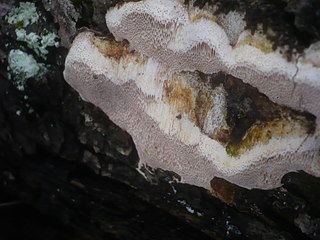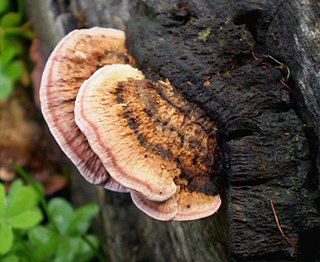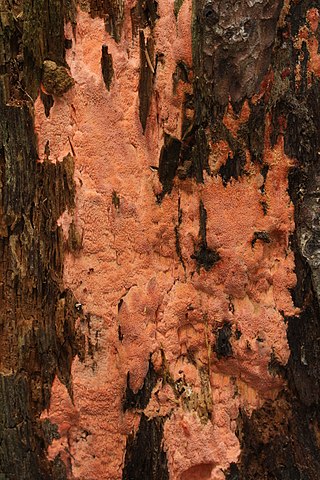
The Polyporaceae are a family of poroid fungi belonging to the Basidiomycota. The flesh of their fruit bodies varies from soft to very tough. Most members of this family have their hymenium in vertical pores on the underside of the caps, but some of them have gills or gill-like structures. Many species are brackets, but others have a definite stipe – for example, Polyporus badius.

Perenniporia is a cosmopolitan genus of bracket-forming or crust-like polypores in the family Polyporaceae. They are dimitic or trimitic with smooth, thick-walled basidiospores and cause a white rot in affected wood.

Lentinus is a genus of fungi in the family Polyporaceae. The genus is widely distributed, with many species found in subtropical regions.

Cucurbitaria is a genus of pyrenomycetous fungi in the family Cucurbitariaceae. The genus was circumscribed by Samuel Frederick Gray in 1821.

Globifomes is a fungal genus in the family Polyporaceae. It is a monotypic genus, containing the single North American species Globifomes graveolens, commonly known as sweet knot. This fungus is found fruiting singly or in groups on trunks or logs of hardwood trees, primarily oaks. The fruit body consists of a mass of small overlapping hoof-shaped caps arising from a common core. It is initially dull yellow-brown with tan petal-shaped margins, aging to dark brown.

Hapalopilus rutilans is a species of polypore fungus in the family Polyporaceae. Officially described in 1821, it was transferred to its current genus Hapalopilus six decades later. It is commonly known as the tender nesting polypore, purple dye polypore, or the cinnamon bracket. This widely distributed species is found on five continents. It grows on the fallen or standing dead wood of deciduous trees, in which it fruits singly, in groups, fused, or in overlapping clusters. Fruit bodies are in the form of kidney-shaped to semicircular, cinnamon-orange-brown brackets. The underside of the fruit body features a yellowish to brownish pore surface with tiny angular pores, from which spores are released.

Pycnoporellus alboluteus, commonly known as the orange sponge polypore, is a species of polypore fungus in the family Fomitopsidaceae. Distributed throughout the boreal conifer zone, the fungus is found in mountainous regions of western North America, and in Europe. It causes a brown cubical rot of conifer wood, especially spruce, but also fir and poplar. The soft, spongy orange fruit bodies grow spread out on the surface of fallen logs. Mature specimens have tooth-like or jagged pore edges. A snowbank mushroom, P. alboluteus can often be found growing on logs or stumps protruding through melting snow. Although the edibility of the fungus and its usage for human culinary purposes are unknown, several species of beetles use the fungus as a food source.

Rhodofomitopsis lilacinogilva is a species of bracket fungus in the family Fomitopsidaceae. Known primarily from Australia, it has also been recorded from Brazil and India. It is a white-rot fungus that grows on rotting eucalyptus wood. Its main identifying feature is the lilac colour of the pore surface on the underside of the fruit body.

Laetiporus portentosus is a species of polypore fungus in the family Fomitopsidaceae. It is found in South America, Australia, and New Zealand. It has been used traditionally as a tinder and to carry fire by Australian Aboriginals, and by New Zealand Māori people. The Māori have also used it as a "wound protector, to soften and ease a difficult labor."

Nigroporus vinosus is a species of poroid fungus in the family Steccherinaceae, and the type species of the genus Nigroporus. Its fruit bodies have brownish caps with tinges of purple or red. The cap underside has a pore surface the same colour as the cap, and minute pores. Nigroporus vinosus has a pantropical distribution. It has been recorded from Africa, North America, Central America, South America, Asia, and Oceania. It is a wood-decay fungus that causes a white rot.

Rhodonia is a fungal genus in the family Fomitopsidaceae. It is a monotypic genus, containing the single crust fungus Rhodonia placenta. A brown rot species, R. placenta is found in China, Europe, and North America, where it grows on decaying conifer wood.

Isaria is a genus of fungi mostly in the order Hypocreales and family Clavicipitaceae, or by some authorities the Cordycipitaceae. It includes a large number of entomopathogenic species, some of them exploited as biopesticides : often previously assigned to the genus Paecilomyces.
Anjali Roy was an eminent Indian mycologist and academician. The fungus genus Royoporus is named in her honour.












